Accepted Scientific Name: Adromischus cooperi (Baker) A.Berger
Nat. Pflanzenfam., ed. 2 [Engler & Prantl] 18a: 416 1930. Engl. & Prantl
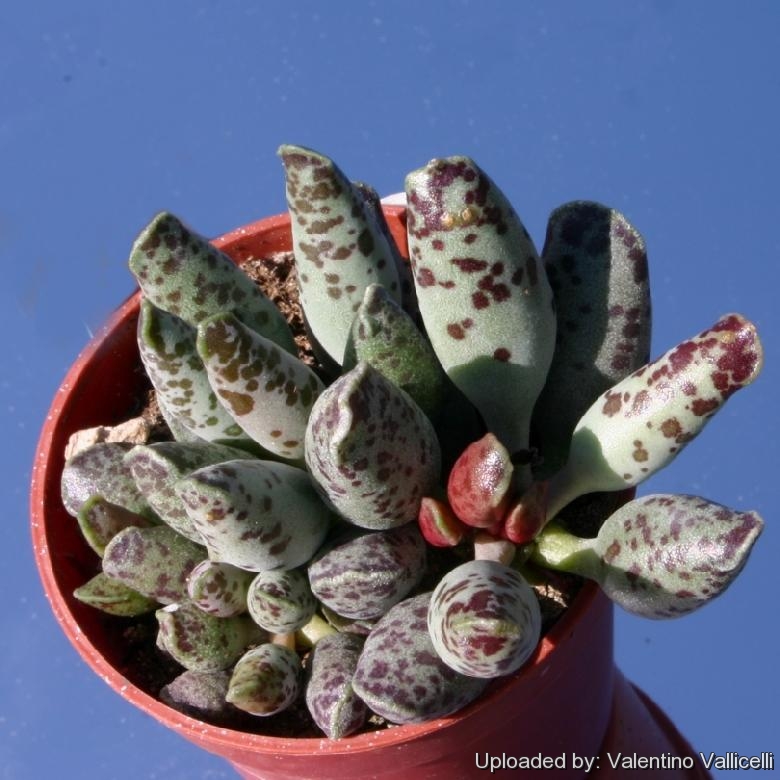
Adromischus festivus
This species is absolutely adorable. Since it is highly variable in leaf markings and colour, it is worth collecting many forms.
Origin and Habitat: South Africa (High up on mountains in the Eastern Cape, Noorsveld)
Synonyms:
See all synonyms of Adromischus cooperi
back
Accepted name in llifle Database:Adromischus cooperi (Baker) A.BergerNat. Pflanzenfam., ed. 2 [Engler & Prantl] 18a: 416 1930.Synonymy: 8
back
Common Names include:
ENGLISH: Plover eggs, Club-adromischus
AFRIKAANS (Afrikaans): Knuppelplakkie
Description: Adromischus festivusSN|27468]]SN|139]] is a dwarf succulent, up to 7 cm tall, leaves 2.5 to 5 cm long. Form groups of stems.
Stem: Knobbly, stout very short, prostrate, with sparse branching. Older plants develop a massive caudex or large swollen area near the ground. Stems lacks root-hairs (unlike Adromischus cristatusSN|139]]SN|134]])
Roots: Fibrous roots
Leaves: Fat, glabrous, small semi cylindrical, more or less mottled with dark green to red based on the exhibition of the plant to the light. Juvenile leaves can be broad with a long margin.
Flowers: Very small, sessile, white-cream or pinkish with violet tones, dusty looking, on a 25-60cm tall inflorescence.
Fruit: Fruit a dry many seeded follicle.
Remarks: Adromischus festivusSN|134]]SN|139]] and the related Adromischus cooperiSN|139]]SN|27468]] are so much confused that a considerable amount of Journal space was given up to discussions about them.
Subspecies, varieties, forms and cultivars of plants belonging to the Adromischus cooperi group
 Adromischus cooperi (Baker) A.Berger: has silver-grey leaves elegantly spotted with rich dark purple with a distal white, slightly wavy horny leaf margins. Distribution: Soutvlei in the Zuur Mountains, E. Cape
Adromischus cooperi (Baker) A.Berger: has silver-grey leaves elegantly spotted with rich dark purple with a distal white, slightly wavy horny leaf margins. Distribution: Soutvlei in the Zuur Mountains, E. Cape Adromischus festivus C.A.Sm.: leaves small semi cylindrical, more or less mottled with red. Juvenile leaves can be broad with a long margin. Distribution: Noorsveld, Eastern Cape.
Adromischus festivus C.A.Sm.: leaves small semi cylindrical, more or less mottled with red. Juvenile leaves can be broad with a long margin. Distribution: Noorsveld, Eastern Cape.
Bibliography: Major references and further lectures
1) John Pilbeam, Chris Rodgerson, Derek Tribble “Adromischus” Cirio Publishing Services Ltd, 1998
2) Hermann Jacobsen “Abromeitiella to Euphorbia” Blandford Press, 1960
3) Christopher Brickell "RHS Encyclopedia of Plants and Flowers” Dorling Kindersley Ltd, 01/Sep/2010
4) Ernst Van Jaarsveld, Ben-Erik Van Wyk, Gideon Smith “Succulents of South Africa: A Guide to the Regional Diversity” Tafelberg Publishers, Limited, 01/Jul/2000
5) Hermann Jacobsen “A handbook of succulent plants: descriptions, synonyms, and cultural details for succulents other than Cactaceae” Volume 1 Blandford Press, 1960
6) Dr J.P. Roux “Flora of South Africa” 2003
7) Doreen Court “Succulent Flora of Southern Africa” CRC Press, 01/giu/2000
8) Hermann Jacobsen “A handbook of succulent plants: descriptions, synonyms, and cultural details for succulents other than Cactaceae” Volume 1 Blandford Press, 1960
9) Urs Eggli “Illustrated Handbook of Succulent Plants: Crassulaceae” Springer for Science, 01/Jan/2003
10) James Cullen, Sabina G. Knees, H. Suzanne Cubey “The European Garden Flora Flowering Plants: A Manual for the Identification of Plants Cultivated in Europe, Both Out-of-Doors and Under Glass” Cambridge University Press, 11/Aug/2011
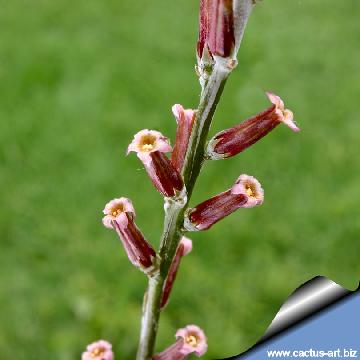 Adromischus festivus Photo by: Cactus Art
Adromischus festivus Photo by: Cactus Art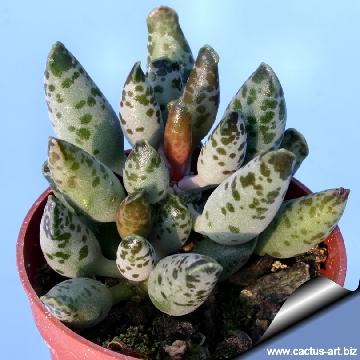 Adromischus festivus Photo by: Cactus Art
Adromischus festivus Photo by: Cactus Art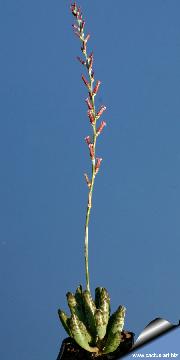 Adromischus festivus Photo by: Cactus Art
Adromischus festivus Photo by: Cactus Art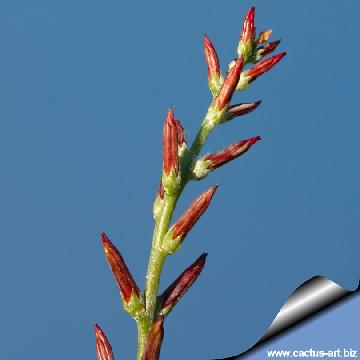 Adromischus festivus Photo by: Cactus Art
Adromischus festivus Photo by: Cactus Art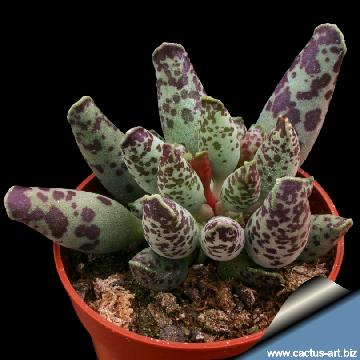 Adromischus festivus Photo by: Cactus Art
Adromischus festivus Photo by: Cactus Art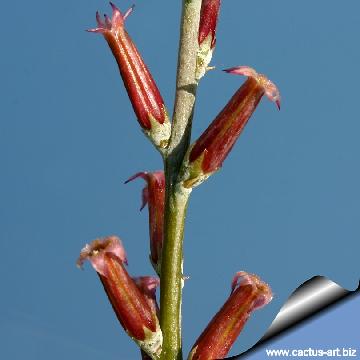 Adromischus festivus Photo by: Cactus Art
Adromischus festivus Photo by: Cactus Art Adromischus festivus Photo by: Cactus Art
Adromischus festivus Photo by: Cactus Art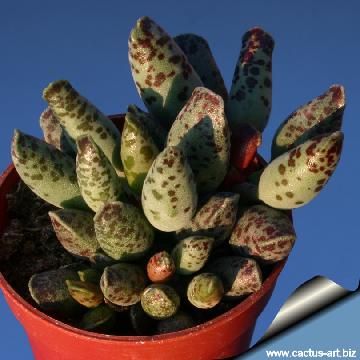 Adromischus festivus Photo by: Cactus Art
Adromischus festivus Photo by: Cactus ArtCultivation and Propagation: They prefer well-drained soil in a partially shaded position and require a minimum temperature 5°C (But hardy down to -7°C for short periods), with good drainage and dryness in winter to resist the cold. Let the soil dry between soaking, in the wild, it receives rain mostly in spring and fall. Must have very dry atmosphere. They are vulnerable to mealybugs and rarely scale. It is prone to rotting from the tuberous base or from dried inflorescences. As the plant matures, the centre becomes bare. When it does, restart it from side cuttings and throw away the central part.
Propagation: Usually propagate from single leaves (leaf cuttings) or stem cuttings seed propagation is rarely used.
Twist off a leaf and permit it to dry out a couple of days, lay it on the soil and insert the stem end partially into the soil. The original leaf should not be removed until it has dried up. Try to keep the leaf somewhat upright so that the roots are able to grow downward. If grown in a container, bottom watering by immersing the container is recommended.



















